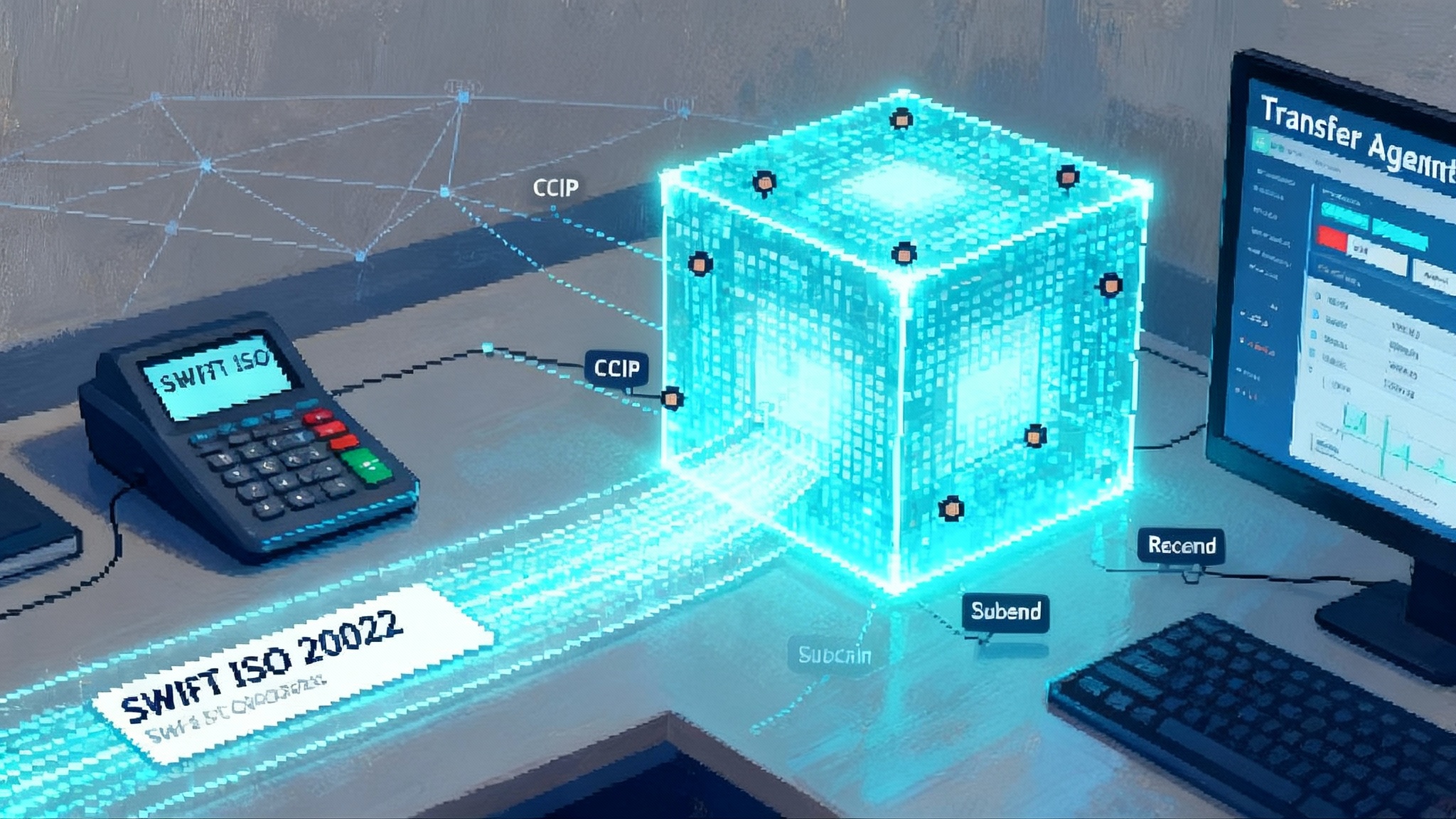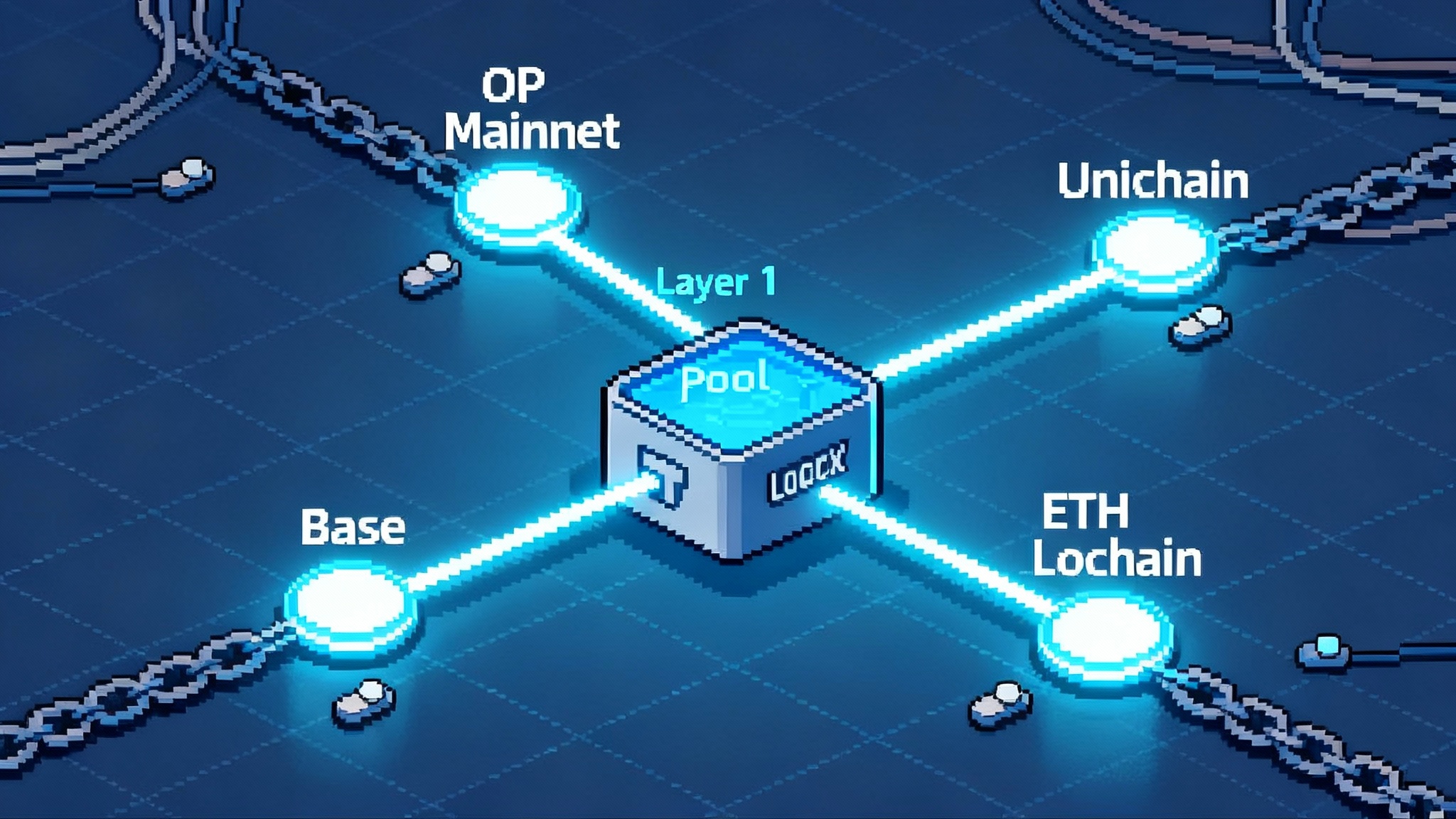Swift and Chainlink turn ISO 20022 into onchain fund flows
A new Swift, UBS and Chainlink pilot shows how standard ISO 20022 bank messages can mint and burn tokenized fund units onchain. Here is what shipped, why settlement compresses, what this unlocks for corporate actions and RWAs, and how builders can plug in.

The week tokenized funds met the bank rails they already use
In late September 2025, a quiet switch flipped. Swift, UBS Asset Management, and Chainlink completed a pilot that let a standard ISO 20022 bank message trigger onchain fund subscriptions and redemptions. It sounds small. It is not. The result is a bridge from bank back offices to onchain fund logic that uses the same messaging format and the same Swift connectivity that institutions already operate every day. You can read Swift’s summary of the pilot in the official recap: Swift, UBS and Chainlink pilot.
What actually shipped is simple to describe and powerful in effect. UBS sent the usual subscription or redemption instructions as ISO 20022 messages over Swift. Chainlink’s Runtime Environment, known as CRE, received those messages and orchestrated the onchain side. The workflow validated the instruction, applied policy checks, and then interacted with a tokenized fund smart contract to mint or burn units. The bank did not need to build a new blockchain gateway, retrain operations teams, or redesign identity and key management. The bank spoke Swift. CRE spoke blockchains.
Think of Swift as air traffic control for financial messages. Think of CRE as the autopilot that understands air traffic control’s instructions and then flies the plane inside the onchain environment. The controller did not change. The autopilot learned a new route.
Why this compresses settlement time
Most fund subscriptions and redemptions still shuffle between messaging, manual checks, reconciliation, and batch updates. Timelines stretch across days. A point of friction is the hop from the message that says what should happen to the system that makes it happen. The pilot removed that hop. When the ISO 20022 instruction arrives, CRE turns it into onchain actions that finalize the asset leg of the transaction. The payment leg still runs over existing rails, but the asset leg no longer waits on end of day processes.
Compression comes from four changes:
-
Fewer handoffs. The same instruction that already passes sanctions screens and reference data checks now programmatically triggers a mint or burn. The fewer queues you join, the fewer queues can delay you.
-
Deterministic asset events. Onchain mint or burn events settle with finality. That finality shortens downstream processes like record date capture and distribution eligibility.
-
Shared state. Instead of every participant keeping their own status spreadsheet, the chain is the system of record. Fewer breaks. Fewer investigations. Less overnight reconciliation.
-
Straight through corporate actions. If the same onchain representation is used for corporate actions, coupon accruals, and income distributions, then the system can chain events together automatically. The result is real time eligibility, fewer exceptions, and lower operating cost per action.
These are not abstract promises. They are immediate side effects of making ISO 20022 messages executable instructions rather than advisory notes.
The next unlocks: corporate actions, RWA distribution, and bank to DeFi
-
Corporate actions. Corporate actions are a maze of unstructured notices, manual enrichments, and late-breaking corrections. The same CRE workflows that decode and enforce subscription messages can validate action terms, assemble ISO 20022 messages, and post a synchronized onchain record. That makes eligibility, payment options, and deadlines machine readable across custodians and fund administrators. When combined with onchain fund units, you get clean record date snapshots and automated entitlements.
-
Real world asset distribution. Asset managers want to distribute tokenized funds to more channels without onboarding an entirely new technology stack each time. If a distributor already speaks Swift, they can originate standard instructions that map to onchain operations by policy. That keeps distribution aligned with existing KYC and AML frameworks while opening new channels. For the market backdrop on fiat rails and compliance, see our context on stablecoin risks at $300B.
-
Bank to DeFi interoperability. Today many banks touch DeFi indirectly through structured products and wrapped exposures. With CRE as an orchestrator and Cross Chain Interoperability Protocol, or CCIP, as a network connector, you can route exposure to multiple chains while keeping bank systems on the same Swift rails they already use. The bridge is policy controlled. For how DeFi plumbing is evolving, examine Aave V4’s modular redesign.
What shipped under the hood
Two technical pieces matter here: CRE and the Digital Transfer Agent standard.
-
CRE is an execution environment where workflows respond to triggers, run checks, read and write onchain, and call external systems. In this pilot, the trigger was an ISO 20022 message. The actions included formatting and submitting onchain transactions against a tokenized fund smart contract.
-
The Digital Transfer Agent, or DTA, is a technical standard Chainlink introduced to formalize onchain fund operations. It models the actions a traditional transfer agent performs, like subscribe, redeem, freeze, or transfer. In the UBS pilot, CRE used a DTA compliant workflow to mint and burn fund units when Swift messages instructed those actions. Chainlink has shared a technical overview: Digital Transfer Agent standard.
The emphasis is on orchestration rather than reinvention. The bank’s operations and controls remain anchored in Swift. The onchain contract provides the asset logic. CRE coordinates the two.
A concrete walkthrough: a UBS subscription
-
The investor’s distributor sends a subscription instruction as an ISO 20022 message. The message includes the investor identifier, fund identifier, amount, settlement instructions, and compliance tags.
-
The message travels over Swift as usual. The bank’s back office sees no new channel or format.
-
CRE receives the message through a connector that understands ISO 20022 fields and the bank’s policy. The workflow checks that the distributor is authorized, the investor wallet is eligible, and the fund cap is not exceeded.
-
If policy passes, CRE calls the DTA logic to mint the correct number of fund tokens on the target chain. The mint event includes a reference to the original message, which becomes a durable link for audits.
-
The payment leg settles over existing rails. Once funds arrive, the onchain position is already recorded, which simplifies the confirmation and reduces exception handling.
-
If anything fails, CRE emits a clear error back to the bank’s case management, mapped to ISO 20022 error codes, so the normal exception playbooks still apply.
Every step uses components the bank already owns and understands, with a new execution path that eliminates the gap between instruction and action.
What changes for banks and asset managers
-
For banks, the near term benefit is lower integration cost and faster time to market for tokenized assets. No new client gateway. No parallel identity stack. No separate messaging standard. The controls and audit trails that already exist for Swift messages carry over to onchain events through CRE’s mapping and attestations.
-
For asset managers, the win is operational consistency. If every distributor can send a subscription the way they do today, you can accept tokenized fund flows without training hundreds of counterparties. The back office can keep its existing case management, reporting, and reconciliation views while the onchain record reduces breaks and accelerates net asset value cutoffs.
-
For investors, the experience becomes clearer. Orders confirm faster, positions settle with onchain finality, and corporate actions become predictable and machine checkable.
Risks you must solve, not sidestep
-
Custody. Decide how keys are held and how transactions are authorized. If the transfer agent role is expressed in a smart contract, who controls the admin key. Use hardware security modules or multi party computation. Define separation of duties and a change process that matches your bank’s policy.
-
Identity. Wallets need to be bound to legal entities with verifiable credentials. Map your existing know your customer outcomes to wallet policies. Decide how you will revoke or update credentials, especially across chains. Consider support for verifiable legal entity identifiers and attestations that can be checked by CRE before actions execute. For how wallet UX and controls are changing, see smart accounts after Pectra.
-
Compliance. Sanctions screening and travel rule obligations should carry forward. Encode them into the workflow. If a rule changes, your policy repo must update without redeploying smart contracts. CRE helps by letting you version and test policies like code.
-
Data protection. ISO 20022 carries rich data. Do not put personally identifiable information onchain. Use offchain storage with onchain commitments and clear retention policies. Audit your data flows end to end.
-
Operational risk. CRE becomes a critical system. Treat it like one. Production grade observability, change management, chaos testing, and disaster recovery are not optional.
-
Vendor and concentration risk. If a single oracle provider coordinates your asset workflows, design for graceful degradation. Keep a plan to fall back to manual processes during outages. Evaluate independent attestation for key events.
Builder’s checklist: two integration paths
There are two practical ways to plug into this new pattern. Pick one to start, then add the other when you scale across chains and counterparties.
Path A: CRE first, Swift trigger
-
Connect Swift to CRE. Use a connector that accepts ISO 20022 subscription and redemption messages and converts them into workflow triggers. Keep your Swift interface and message validation exactly as is.
-
Map messages to DTA actions. Start with subscribe and redeem, then add transfer, freeze, and cancel. Keep a clear mapping table from message fields to contract parameters. Include references to the original message identifiers for traceability.
-
Encode policy as code. Put eligibility, caps, cutoffs, and jurisdiction checks into the workflow. Store policies in a versioned repository. Use test cases based on historical exceptions.
-
Choose chains and contracts. Deploy the fund contract on the chain where liquidity and compliance requirements align. Use a standard that your administrator and custody partners can support. Scope gas budgets and set alerting for fee spikes.
-
Design audit trails. Log the incoming message, policy evaluation results, onchain transaction hashes, and the acknowledgment back to Swift. Make sure each event ties back to an immutable reference in case management.
-
Start with a shadow run. Mirror live messages to a test environment. Validate that onchain outcomes match back office expectations before turning on mint and burn in production.
Path B: CCIP for cross chain, CRE for policy
-
Identify the cross chain need. If your distribution, liquidity, or collateral logic spans multiple chains, plan for CCIP to route messages and value across them.
-
Keep CRE as the policy gate. Even when instructions arrive from a chain rather than Swift, run them through the same policy code. That way, onchain and offchain orders meet the same standards.
-
Standardize event schemas. Define a message schema for orders and actions that is chain agnostic. Use CCIP to transport the payload and CRE to enforce policy and deliver the final write to the destination contract.
-
Manage token representations. Decide whether you will mirror fund units on multiple chains or keep a single issuance chain with wrapped representations elsewhere. Use CCIP to burn and mint representations so supply remains consistent.
-
Build safe bridges to DeFi. If you allow fund units to be used as collateral in decentralized finance, add whitelist checks and concentration limits in the CRE workflow. Monitor liquidity and price feeds. Design emergency actions that can pause flows while preserving investor rights.
-
Expand monitoring. Cross chain means more failure modes. Instrument message delivery times, failure rates, and chain specific gas dynamics. Alert on divergence from expected patterns.
Early metrics that matter
-
Order cycle time from Swift message ingest to onchain confirmation. Target minutes, not hours.
-
Exception rate by cause. Break down eligibility failures, data quality issues, and contract reverts. Fix the top three sources.
-
Corporate action timeliness. Measure time from record date to entitlement distribution for tokenized units versus traditional units.
-
Distribution coverage. Count how many existing distributors can send ISO 20022 messages without changes to reach your tokenized funds.
-
Onchain liquidity utilization. If you allow secondary trading or collateralization, monitor turnover and borrowing rates. Ensure they align with the fund’s risk profile.
-
Policy change lead time. Track how long it takes to change a rule in the workflow and deploy to production with sign offs.
What this signals for the road ahead
Three shifts are now visible.
-
The messaging standard is the bridge. The most important integration was not a new wallet or a custom gateway. It was mapping ISO 20022 instructions to onchain actions. That is how you bring thousands of institutions along without forcing them to rebuild the plane in flight.
-
The transfer agent is becoming code. By modeling transfer agent functions as smart contracts and workflows, you move from paper backed authority to policy backed execution. Controls become testable and repeatable. Audits become faster.
-
Interoperability becomes a service, not a project. With CRE to orchestrate policy and CCIP to connect chains, you can add chains or distribution channels by configuration. You do not need a new project for each addition.
This is not about crypto adoption for its own sake. It is about making existing capital markets cheaper, faster, and more controllable by connecting what banks already use to what blockchains already do well.
The bottom line
The breakthrough is not a shiny new app. It is the decision to let existing Swift messages drive onchain fund logic. That is why the pilot mattered. It gave banks a route to tokenized funds that fits their current systems and risk frameworks. It gave asset managers a way to accept onchain subscriptions without reengineering their distribution. And it gave builders a clear checklist for how to integrate.
The first production rollouts will look modest. A single fund. A handful of distributors. A limited set of actions. That is fine. The path is clear. Start with ISO 20022 triggers. Encode policy in CRE. Use DTA to keep fund logic clean. Add CCIP when you need to cross chains. Measure everything. With each cycle your settlement shortens, your exceptions fall, and your distribution footprint grows.
When you can mint or burn a regulated fund directly from the message your back office already trusts, you have moved from promise to practice. The rest is execution.








